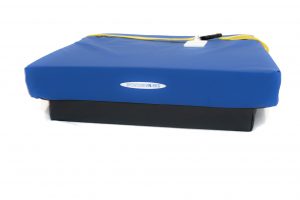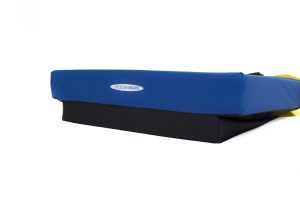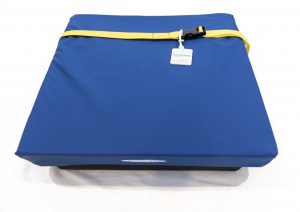ENGAGE APOD®
(Advanced Positioning Orthotic Device)
The Engage APOD® provides advanced positioning support and skin protection for people who are unable to independently maintain an upright seated position in their wheelchair by combining the structure of orthotics with principles of wheelchair seating.
The Engage APOD® biomechanically aligns the hips and pelvis to address the etiology of medium to severe wheelchair positioning abnormalities to reduce restraints, falls, pressure injuries, aspiration, pain, and re-hospitalizations. Upright and midline positioning is maintained to engage the user both physically and psycho-socially to improve safety, comfort, and dignity.
| Addresses the Etiology of Common Positioning Abnormalities | |
|
|
The PostureWorks Engage
provides us with a whole new
avenue for positioning that we didn’t
have before. We have used it with our
most difficult positioning residents and they
are all sitting beautifully. It is putting their
entire body into alignment, and we are seeing
carryover in their ability to eat, reducing the
risk of aspiration.
Ruth Donovan, OTR/L
Canton, MA
| Product Features |
||||
| Base | Anthropometrically designed rigid base creates a secure pre-ischial shelf to stabilize the pelvis. Weight is redistributed over a larger surface area to reduce pressure over ischial tuberosities, coccyx, and sacrum | |||
| Anterior Bolsters | Anterior height varies from 3-5.5 inches The anterior bolster height encourages the desired degree of hip flexion to minimize sliding forward |
|||
| Medical-Grade Foam | Medical-grade visco and high-density foams are shaped to create a pelvic well posteriorly to promote a neutral pelvis and upright midline position, while still allowing for sage, functional transfers | |||
| Cover Technology | Premium, medical-grade, Dartex fabric is engineered specifically for infection control. It is anti-microbial and impenetrable to fluids; ultrasonically welded seams protect core; 4-way stretch properties manage pressure and reduce shear forces; Non-skid bottom | |||
| Color-Coded Straps | Color-coded straps secure the cushion in place and serve as a visual cue to indicate cushion intervention level for caregivers
|
|||
| Identification Tags | ID tags help keep cushions with users | |||
| Latex Free | ||||
| Product Warranty | Engage APOD® cushions are warrantied to be free of manufacturing and material defects for a period of 18 months. Covers have a 90 day warranty. Normal wear or damage due to abuse, misuse, or neglect is not covered under warranty. | |||
| Made in the USA |
 |
|||
| Common Diagnoses Associated with Positioning Abnormalities | |
|
|
| Engage APOD Treats the Underlying Cause of Common Survey TAGs in SNFs |
|
| F686 Pressure Injuries |
Ensure resident does not develop pressure injury unless clinically unavoidable; Engage APOD is a particularly effective seating intervention when the etiology of the wound is a positional abnormality. The Engage APOD® has been used in the care plans of patients with pressure injuries. If your patient has a pressure injury, or a history of pressure injuries, please click here for support to review considerations for proper fit and function of this seating intervention. |
| F689 Falls |
Resident environment remains as free of accident/falls as possible; resident receives supervision and assistance devices to prevent accidents. The Engage APOD is used to address and correct positioning abnormalities that cause falls. Click here for support. |
| F697 PainF757 Unnecessary Drugs F758 Psychotropic Drugs |
Ensure that pain management is provided consistent with professional standards of practice, care plan, and the resident’s goals and preferences. The Engage APOD has been used in care plans to treat the underlying cause of pain and mitigates further use of pain medications; this dovetails with Tag F757 (unnecessary drugs) and Tag F758 (psychotropic drugs). |
| F604 Restraints |
Resident’s right to be free from physical restraints. The Engage APOD is an intervention that is often used to remove restraints by addressing the etiology of the need for the restraint |
| F675 Quality of Life |
The Engage APOD creates a stable, comfortable platform for living. Proximal stability enhances distal mobility to enhance a resident’s ability to perform ADLs. |
| Contraindications: |
(*)Contractures can be due to tonal patterns or to collagen build-up and adhesions. A low load, long-duration stretch with APOD may be possible to increase ROM. Click the chat icon in the bottom right for clinical support, or click here to contact us. |
| Reminders: |
|
| Engage APOD® Product Specifications | |
| Cushion Width | 16″, 18″, 20″, 22″ |
| Cushion Depth | 16″, 18″ |
| Cushion Height (Anterior) |
Low Profile: 3″ Medium Profile: 5″ High Profile: 5.5″ |
| Cushion Height (Posterior) |
Low Profile: 2″ Medium Profile: 2″ High Profile: 2″ Note: The posterior height of the cushion will vary depending on the user’s anatomy and how much the wheelchair seat is hammocked posteriorly. |
| Cushion Weight (Standard Size 18″x16″) |
Low Profile: 3 lbs, 5 oz Medium Profile: 4 lbs, 3 oz High Profile: 4 lbs, 5 oz |
| Weight Guideline (Standard Size 18″x16″) |
250 lbs |
| Latex Free | |
| Product Warranty | Engage APOD® cushions are warrantied to be free of manufacturing and material defects for a period of 18 months. Covers have a 90 day warranty. Normal wear or damage due to abuse, misuse, or neglect is not covered under warranty. |
| Made in the USA | |
All PostureWorks products are designed for infection control. The medical-grade cover has ultrasonically welded seams and an anti-microbial coating to create a barrier to fluids.
Spray and wipe clean with a standard disinfectant. The cover is non-removable so it will not get lost in the wash!
Click Here for Manufacturer’s Instructions
| Considerations When Selecting a Wheelchair Cushion |
|
| Considerations for Maintaining a Wheelchair Cushion |
|
Effective wheelchair seating interventions improve safety and comfort, as well as help people engage the world in a healthy, dignified, and meaningful manner.
If you have questions or would like further assistance please contact The PostureWorks.
Our team of therapists will be standing by ready to assist you!
As a part of our ongoing product improvement processes, The PostureWorks reserves the right to change product specifications without notice. Actual user evaluations, and decisions regarding the appropriateness of a particular product for a particular individual, should always be made by a qualified healthcare professional.



